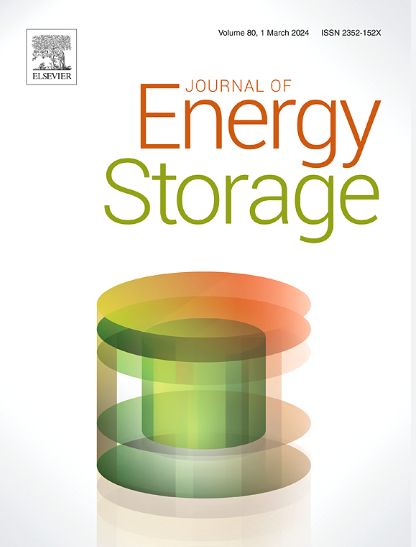纳米结构V2O5基丝网印刷油墨的制备:面向微型超级电容器的制造
IF 8.9
2区 工程技术
Q1 ENERGY & FUELS
引用次数: 0
摘要
随着柔性电子技术的不断发展,对具有同样适应性的储能解决方案提出了更高的要求,从而突破了传统的三明治结构器件的界限,这些器件存在安全问题、能量密度有限、机械灵活性差等问题。平面内微型超级电容器(MSCs)已成为一种优越的替代方案,印刷技术提供了一种可扩展且具有成本效益的制造方法。在这里,我们开发了一种基于超声合成纳米结构V2O5 (usN-V2O5)的丝网印刷油墨,用于在刚性氧化铝和柔性PET衬底上制造高性能的MSCs,利用银印刷的集电极进行有效的电荷传输。为了调整电化学性能,我们采用了两种不同的电解质:聚丙烯酰胺(PAM)-Li2SO4凝胶具有优异的稳定性,1-乙基-3-甲基咪唑四氟硼酸盐(EMIM BF4)离子液体(IL)具有扩展的电化学窗口和增强的能量密度。氧化铝衬底上基于PAM-Li2SO4的MSC提供了49.9 F cm - 3的卓越比电容,在10,000次循环中保持87.75%的保留率,而PET上基于il的MSC在1609.39 mW cm - 3时达到了令人印象深刻的2.25 mWh cm - 3的能量密度,显著优于PAM-Li2SO4(在1000 mW cm - 3时1.70 mWh cm - 3)。值得注意的是,它在机械灵活性方面表现出色,即使在300次弯曲循环后仍能保持电荷存储性能,这增强了它在可穿戴和可拉伸电子产品方面的潜力。这些发现强调了基于usn - v2o5的丝网印刷MSCs作为下一代柔性和高能量密度储能设备的改变游戏规则的解决方案的前景。本文章由计算机程序翻译,如有差异,请以英文原文为准。
Formulation of nanostructured V2O5 based screen printable ink: Toward fabrication of micro-supercapacitors
The continuous growth in flexible electronics evolution of flexible electronics demands equally adaptable energy storage solutions, pushing the boundaries beyond conventional sandwich-structured devices that suffer from safety concerns, limited energy density, and poor mechanical flexibility. In-plane micro-supercapacitors (MSCs) have emerged as a superior alternative, with printing technology offering a scalable and cost-effective fabrication approach. Here, we develop a screen-printable ink based on ultrasonically synthesized nanostructured V2O5 (usN-V2O5) to fabricate high-performance MSCs on both rigid alumina and flexible PET substrates, utilizing silver-printed current collectors for efficient charge transport. To tailor electrochemical performance, we employ two distinct electrolytes: polyacrylamide (PAM)-Li2SO4 gel for exceptional stability and 1-Ethyl-3-methylimidazolium tetra fluoroborate (EMIM BF4) ionic liquid (IL) for an expanded electrochemical window and enhanced energy density. The PAM-Li2SO4 based MSC on alumina substrate delivers an outstanding specific capacitance of 49.9 F cm−3, maintaining 87.75 % retention over 10,000 cycles, while the IL-based MSC on PET achieves an impressive energy density of 2.25 mWh cm−3 at 1609.39 mW cm−3, significantly outperforming its PAM-Li2SO4 counterpart (1.70 mWh cm−3 at 1000 mW cm−3). Notably, it excels in mechanical flexibility, retaining charge storage performance even after 300 bending cycles, reinforcing its potential for wearable and stretchable electronics. These findings underscore the promise of usN-V2O5-based screen-printable MSCs as a game-changing solution for next-generation flexible and high-energy-density energy storage devices.
求助全文
通过发布文献求助,成功后即可免费获取论文全文。
去求助
来源期刊

Journal of energy storage
Energy-Renewable Energy, Sustainability and the Environment
CiteScore
11.80
自引率
24.50%
发文量
2262
审稿时长
69 days
期刊介绍:
Journal of energy storage focusses on all aspects of energy storage, in particular systems integration, electric grid integration, modelling and analysis, novel energy storage technologies, sizing and management strategies, business models for operation of storage systems and energy storage developments worldwide.
 求助内容:
求助内容: 应助结果提醒方式:
应助结果提醒方式:


